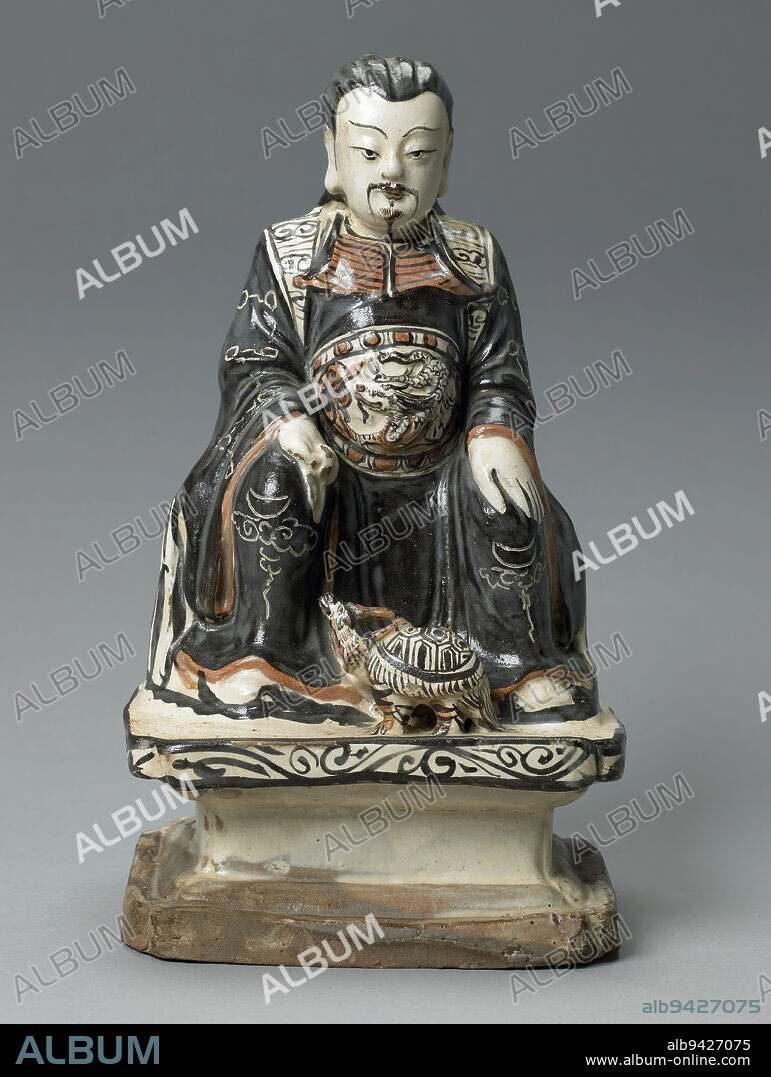alb9427075
Chen-Wu, The Taoist Deity of the North, 14th-15th century, 11 1/2 x 5 1/4 x 6 1/2 in. (29.21 x 13.34 x 16.51 cm), Tz'u-chou ware Slip-coated stoneware with dark brown and russet brown painted décor under a clear glaze., China, 14th-15th century, The origins of the deity Zhenwu (perfected warrior) go back to the Warring States (3rd century b.c.) and Han dynasty (206 b.c.-220 a.d.) periods. At that time, he was known as Xuanwu (the dark warrior), and was simply represented by a tortoise entwined by a snake. Xuanwu was the ancient symbol of the north and often appeared with three other animals: the dragon, red bird, and tiger, to symbolize the four directions. The transformation of Xuanwu from a snake-entwined tortoise to the Daoist deity Zhenwu, represented as a robust human-form warrior, occurred around 1000 a.d. The period of Zhenwu's greatest popularity was the Ming dynasty (1368-1644).

|
Zu einem anderen Lightbox hinzufügen |
|
Zu einem anderen Lightbox hinzufügen |



Haben Sie bereits ein Konto? Anmelden
Sie haben kein Konto? Registrieren
Dieses Bild kaufen.
Nutzung auswählen:

Untertitel:
Siehe automatische Übersetzung
Chen-Wu, The Taoist Deity of the North, 14th-15th century, 11 1/2 x 5 1/4 x 6 1/2 in. (29.21 x 13.34 x 16.51 cm), Tz'u-chou ware Slip-coated stoneware with dark brown and russet brown painted décor under a clear glaze., China, 14th-15th century, The origins of the deity Zhenwu (perfected warrior) go back to the Warring States (3rd century b.c.) and Han dynasty (206 b.c.-220 a.d.) periods. At that time, he was known as Xuanwu (the dark warrior), and was simply represented by a tortoise entwined by a snake. Xuanwu was the ancient symbol of the north and often appeared with three other animals: the dragon, red bird, and tiger, to symbolize the four directions. The transformation of Xuanwu from a snake-entwined tortoise to the Daoist deity Zhenwu, represented as a robust human-form warrior, occurred around 1000 a.d. The period of Zhenwu's greatest popularity was the Ming dynasty (1368-1644).
Persönlichkeiten:
Bildnachweis:
Album / quintlox
Freigaben (Releases):
Model: Nein - Eigentum: Nein
Rechtefragen?
Rechtefragen?
Bildgröße:
3604 x 4786 px | 49.3 MB
Druckgröße:
30.5 x 40.5 cm | 12.0 x 16.0 in (300 dpi)
Schlüsselwörter:
 Pinterest
Pinterest Twitter
Twitter Facebook
Facebook Link kopieren
Link kopieren Email
Email
